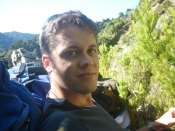Visiting an archaeological site
Urban Wellington is dotted with archaeological traces of Maori pa sites (fortified villages), urupa (burial grounds), cultivation grounds, house and kumara pits and other remains of a pre-European era. Experience tells me that students are largely unaware of these places, many of them found on a beautiful, rugged coastline only 15 minutes from Parliament buildings. While some traces are more visible than others, these archaeological sites provide an excellent opportunity to help students think about an historical era that is very different to their own. I took a group of 50 year 11 students to one such location called Oruaiti and used this opportunity to develop their historical thinking.
Oruaiti and surrounding pa sites are places of significant cultural, historical and spiritual importance, especially for Maori tribes around the harbour. One location (which we unfortunately had to cut on the day due to time restraints) had been the site of a Musket Wars raid in the early 1820s resulting in some grisly deaths. Do these factors shape how we should act at these locations today? I contacted the local tribal authority and it was suggested to me I developed with students what we considered to be appropriate tikanga (general behaviour guidelines) when visiting local Maori archaeological sites. Students came up with the following:
• No re-enacting historical events
• No eating at the sites
• Stay respectful (no running, playing around, stay on task)
I thought this was a good start (as did the tribal authority) and the exercise modeled some important cultural considerations. It reminded me of an experience I had at Auschwitz concentration camp where I witnessed a group of pupils eating chippies, laughing and being silly. While a world away from Poland and Nazi Germany, some places demand more respect than that.
At the site I asked students to explore the question “How would Maori have sustained their community at Oruaiti Pa?”. They were given the categories food/water, shelter, weather, protection from enemies and trade and were asked to draw from a heritage trail booklet produced by the city council, the landscape itself, and any interpretation panels at the site. The results were positive, and I especially enjoyed seeing students look at the landscape critically and carefully to build tentative speculations. For example, they questioned the extent to which Oruaiti had any permanent population due to its exposure to the elements. Perhaps it was just a lookout? They asked what Maori would have done for water storage and started thinking about where the nearest streams or springs were. They considered the superiority of the site as protection from enemies. They wondered about the strategic advantages of controlling trade given the site’s proximity to the harbour entrance, when the pa was last used, when it was first settled, and how many people the area had sustained. These questions provide fertile ground for further exploration of pre-European local history.


